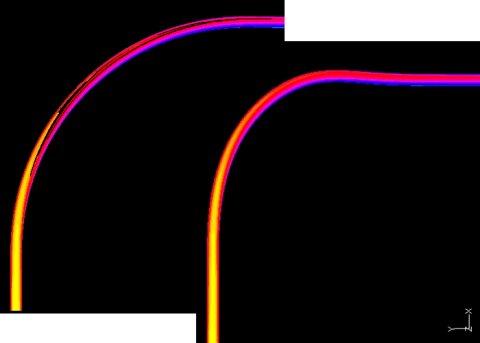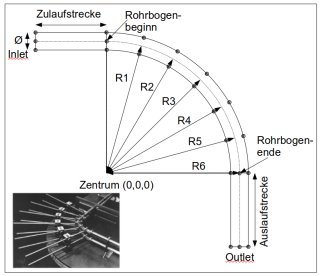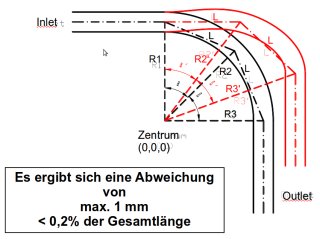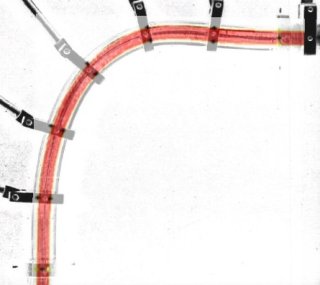 [Home] → [Projects] → [Pipe bend optimisation]
[Home] → [Projects] → [Pipe bend optimisation]
Full text of the thesis is available on ResearchGate
Geometry optimisation for drag reduction of flow-through bodies with the use of evolution-strategic CFD simulation using the example of the 90° pipe bend

In this work, the applicability of an evolution strategy to a CFD (Computational Fluid Dynamics) flow simulation is examined using the example of tube bend optimisation. The diploma thesis of H. J. Lichtfuss[1], who carried out this experiment in the laboratory, serves as a model. Here, the shape of a 90° pipe bend is optimised by means of an (1+1)-evolution strategy[2] changing the geometry with a fully developed turbulent flow. The shape of the bend is controlled by six variable radii, the lengths of which can be suksesively stretched or compressed using random numbers (Fig. 1). The resulting geometry of the pipe run is then calculated for its flow resistance. The optimisation of the geometry, with the aim of minimising the resistance, is governed by the evolution strategy. This is derived from the principles of natural evolution reproduction, mutation and selection, according to which a new generation of children is formed by randomly mutating the parent generation. If the new generation proves to be better with regard to the selection criterion resistance, it becomes the new parent generation, otherwise it is discarded and the previous parent generation remains for the next iteration step.

Figure 1: Experiment set-up according to Lichtfuss[1]. The pipe bend is controlled via six radii, as in the practical experiment.
The data obtained in 1965 are used for comparison and quantitative evaluation of the method. Numerical simulations are approximation methods that can only reflect reality to a limited extent. Therefore, this method test examines whether and to what extent these inaccuracies have an influence on such an optimisation. For this purpose, the geometry is generated via coordinates in the software Gambit and a simulation is calculated with the software Fluent, from the company Fluent Inc. The main focus is set on the calculation of the geometry coordinates in order to represent the behaviour of the pipe through deformation as realistically as possible (Fig. 2), as well as the simulation parameters, the meshing and the turbulence model.

Figure 2: Schematic representation of the geometry generation in order to maintain the pipe length when changing the course.
The data obtained thus serve as the basis for a computer-aided evolution of the pipe bend.
The results indicate enormous potential of the method, as both the virtual adaptation leads to very good results (Fig. 3), but also high flexibility is ensured with regard to adaptation of the boundary conditions, e.g. pipe diameter or bending radius.

Figure 3: Graphical comparison of the CFD model with the result from the laboratory test.
References
[1] Lichtfuss, Hanns-Jürgen (1965): Diplomarbeit, Evolution eins Rohrkrümmers, Technische Universität Berlin.
[2] Rechenberg, Ingo (1994): Evolutionsstrategie ´94, Werkstatt Bionik und Evolutionstechnik, Band 1, Stuttgart: frommann-holzboog, 1994, ISBN: 3-7728-1641-X.
last update: 11 Oct 2023 06:14
